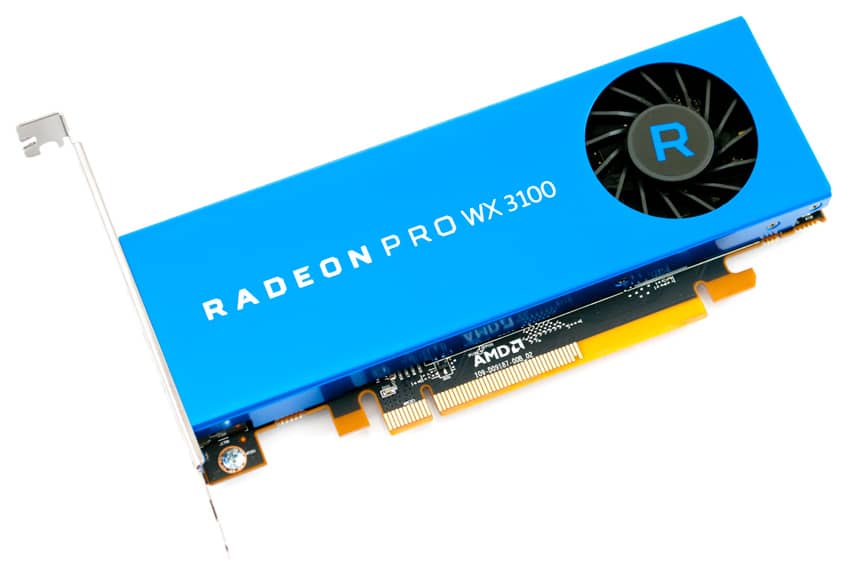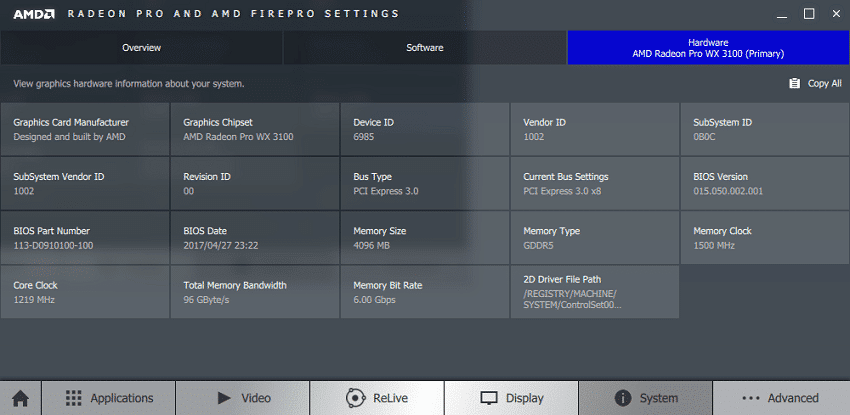At the beginning of the month, AMD launched a pair of new GPUs that address the entry-class performance needs of professionals in popular fields like design and manufacturing, media and entertainment and finance. And while AMD has plenty of specs that show where the new WX 2100 and WX 3100 stand out, they’re really leading with a value-based message. Not just in terms of the $199 MSRP for the WX 3100, but also the fact that they offer a three year warranty (7 optional) with 24/7 local language support and a commitment to quarterly feature, performance and stability improvements. Of course the WX 3100 also has the popular application certifications including SOLIDWORKS, PTC Creo, Siemens NX, and CATIA.

The WX 3100 is based on the 14nm Polaris GPU architecture and is equipped with eight compute units (512 stream processors), 4GB GDDR5 memory (96GB/s bandwidth) and offers 1.25 TFLOPS single precision compute. In aggregate, the WX 3100 is expected to perform 2.3 times better than the prior iteration. AMD maintains a focus of efficiency, the WX 3100 draws a max of 50W with power monitoring and management that is designed to reduce power consumption at idle. The WX 3100 includes three outputs (1xDP, 2x mini DP 1.4) capable of driving three 4K displays at 60Hz or one 5K 30Hz.

AMD Radeon Pro WX 3100 Specifications
- GPU Architecture: Polaris
- Single-Precision Performance: Up to 1.25 TFLOPS
- Double-Precision Performance: Up to 78 GFLOPS
- Memory Configuration: 4GB GDDR5
- Memory Bandwidth: 96 GB/s
- Display Output Connectors: 1xDP, 2x mini DP 1.4 HBR/HDR Ready
- Board Form Factor and Length: Low-Profile
- Thermal: Active, Single Slot
- Maximum TDP Power: <50 W
- HEVC Decode: 8HD / 4K60
- H.265 Encode: 1080P 240 or 4K60 Mixed With Decode
Performance
To test the AMD Radeon Pro WX 3100, we installed it in our desktop workstation, an HP Z640 and ran several relevant benchmarks to evaluate performance when compared to the nearest similar-class GPU in the lab, an NVIDIA M2000. We will be using a benchmark that looks at several aspects of the ArcGIS program; however, we are most interested in the average of the drawtime, average frames per second (Average FPS), and minimum frames per second (Minimum FPS).
Looking at drawtime, the WX measured 9.31 seconds, compared to 6.262 seconds of the M2000. Average FPS, however, showed the WX 3100 with an average of 175.57 FPS. Minimum FPS came in similarly measuring 97.96 FPS.
| ESRI Benchmark | |
|---|---|
| Drawtime | Average |
| HP z640 (WX 3100) | 0:00:09.310 |
| HP z640 (M2000) | 0:00:06.262 |
| Average FPS | Average |
| HP z640 (WX 3100) | 175.57 |
| HP z640 (M2000) | 273.51 |
| Minimum FPS | Average |
| HP z640 (WX 3100) | 97.96 |
| HP z640 (M2000) | 160.51 |
The next benchmark is SPECviewperf 12, the worldwide standard for measuring graphics performance based on professional applications. SPECviewperf runs 8 benchmarks it calls viewsets, which all represent graphics content and behavior from actual applications. These viewsets include: CATIA, Creo, Energy, Maya, Mecial, Showcase, Siemens NX, and Solidworks. Here, the HP Z640 with the ATI WX 3100 showed decent performance, coming in below the M2000, but for the half the price.
| SPECviewperf 12 | ||
|---|---|---|
| Viewsets | HP z640 (WX 3100) | HP z640 (M2000) |
| catia-04 | 45.66 | 69.36 |
| creo-01 | 52.38 | 62.82 |
| energy-01 | 1.98 | 4.07 |
| maya-04 | 33.44 | 49.88 |
| medical-01 | 11.35 | 19.21 |
| showcase-01 | 27.15 | 28.45 |
| snx-02 | 54.57 | 61.94 |
| sw-03 | 69.38 | 91.01 |
Conclusion
AMD bills the new Radeon Pro WX 2100 and WX 3100 as graphics cards that meet entry-level performance needs. In terms of IT marketing, that’s about as honest as it gets and in this case it’s plenty factual. The highlight here though is really about the performance/price equation. When inserted into a relatively well-equipped HP Z640, the WX 3100 handles our real-world ESRI workload pretty well considering the comparable is twice the cost. In SPECviewperf the story is pretty much the same, pretty good performance for the cost of the card. All of these workloads are well within the wheelhouse for places the WX 3100 may be deployed. For those use cases when dedicated graphics are needed to accelerate professional applications, the WX 3100 acquits itself quite nicely for an MSRP of only $199.




 Amazon
Amazon